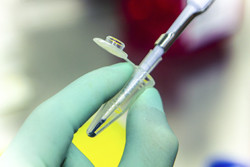Small is beautiful in the RNA world
6S RNA is abundant in bacteria and binds to sigma70-RNA polymerase (sigma70-RNAP). A housekeeper, sigma70 helps to transcribe most genes in growing cells. The 'Structural and functional studies of the interaction between non coding RNAs and the RNA polymerase' (NCRNAP) project, funded by the EU, has investigated the structure of 6S RNA in complex with RNAP. Project researchers successfully isolated 6S RNA from Escherichia coli. Using electroelution and affinity chromatography, they produced a high-purity sample in milligram quantities for continued analysis and structural studies. Protocols were established for production of the nucleoprotein complex in vivo. The sample was analysed using cryo electron microscopy, non-dissociating mass spectroscopy and small-angle X-ray scattering. The development of a low-resolution model of sigma70-RNAP continues. Small non-coding RNAs have been found to form complexes with RNA polymerases in higher animals and plants with a true nucleus. This opens the way to increased understanding of gene expression regulation in more sophisticated systems. Moreover, bacterial RNAP is the target of many classes of antibiotic and structural information could be used to discover new lead compounds.







